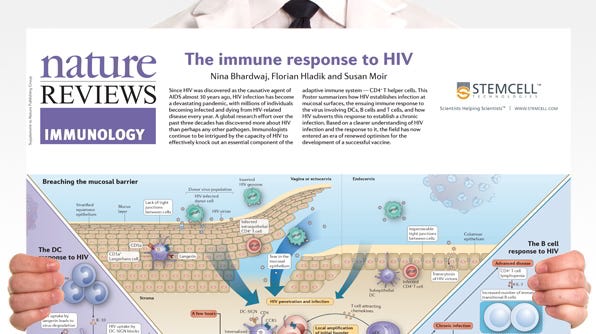Infectious Diseases and Immunology
Infectious diseases are caused by pathogens, including viruses and bacteria. Researchers aim to understand the interactions between these microorganisms and immune cells in order to develop vaccines and therapies against infectious diseases.
Below is a collection of scientific resources for your infectious disease research.
The Immune Response to HIV Poster
Nina Bhardwaj, Florian Hladik and Susan Moir. This Poster summarizes how HIV establishes infection at mucosal surfaces, the ensuing immune response to the virus involving DCs, B cells and T cells, and how HIV subverts this response to establish a chronic infection.
Get Your Free Copy >-
 Cori FainCori Gain discusses her work in the Johnson lab focused on understanding immune-mediated blood-brain barrier disruption in cerebral malaria
Cori FainCori Gain discusses her work in the Johnson lab focused on understanding immune-mediated blood-brain barrier disruption in cerebral malaria -
 Acquiring DNA or RNA from Positively Selected CellsCells positvely selected with the EasySepÔäó system do not interfere with most downstream applications
Acquiring DNA or RNA from Positively Selected CellsCells positvely selected with the EasySepÔäó system do not interfere with most downstream applications -
 How to Isolate Nucleated Cells from Whole Blood Using HetaSepÔäó Erythrocyte Aggregation AgentHetaSepÔäó is an erythrocyte aggregation agent used to quickly separate nucleated cells from red blood cells
How to Isolate Nucleated Cells from Whole Blood Using HetaSepÔäó Erythrocyte Aggregation AgentHetaSepÔäó is an erythrocyte aggregation agent used to quickly separate nucleated cells from red blood cells -
 Unloading the RoboSepÔäó-S CarouselBasic overview on how to use and maintain your RoboSepÔäó-S; steps to unload the instrument after a cell separation run has been completed
Unloading the RoboSepÔäó-S CarouselBasic overview on how to use and maintain your RoboSepÔäó-S; steps to unload the instrument after a cell separation run has been completed -
 How to Isolate PBMCs from Whole Blood Using the SepMateÔäó PBMC Isolation Tubes: 15-Minute ProtocolEasy and rapid procedure for isolating peripheral blood mononuclear cells (PBMCs) from whole blood or bone marrow using the unique SepMateÔäó PBMC isolation tubes
How to Isolate PBMCs from Whole Blood Using the SepMateÔäó PBMC Isolation Tubes: 15-Minute ProtocolEasy and rapid procedure for isolating peripheral blood mononuclear cells (PBMCs) from whole blood or bone marrow using the unique SepMateÔäó PBMC isolation tubes -
 How to Prepare a Single-Cell Suspension from Primary Tissue Samples (e.g. Mouse Spleen)How to harvest cells from a mouse spleen and prepare a single cell suspension prior to performing cell isolation to enable cell separation by minimizing additional cell loss and improving the labeling of target cells
How to Prepare a Single-Cell Suspension from Primary Tissue Samples (e.g. Mouse Spleen)How to harvest cells from a mouse spleen and prepare a single cell suspension prior to performing cell isolation to enable cell separation by minimizing additional cell loss and improving the labeling of target cells -
 Ramin Herati, MDDr. Ramin Herati discusses his work on understanding the mechanism and regulation of T cell exhaustion during chronic infections and cancer
Ramin Herati, MDDr. Ramin Herati discusses his work on understanding the mechanism and regulation of T cell exhaustion during chronic infections and cancer -
 How to Count Cells Using a HemocytometerHow to prepare and count stained cell samples using a hemocytometer for both total nucleated cell counts and viable cell counts
How to Count Cells Using a HemocytometerHow to prepare and count stained cell samples using a hemocytometer for both total nucleated cell counts and viable cell counts -
 Working with Small Sample Volumes or Low Start Cell Numbers Using the Purple EasySepÔäó and EasyPlateÔäó EasySepÔäó PlatformsTechnical tip from our dedicated team of Product and Scientific Support specialists
Working with Small Sample Volumes or Low Start Cell Numbers Using the Purple EasySepÔäó and EasyPlateÔäó EasySepÔäó PlatformsTechnical tip from our dedicated team of Product and Scientific Support specialists -
 Using Cell Density Gradients to Optimize Your Cell IsolationsRosetteSepÔäó, a unique immunodensity cell isolation platform, isolates highly purified cells by density gradient centrifugation without columns or magnets
Using Cell Density Gradients to Optimize Your Cell IsolationsRosetteSepÔäó, a unique immunodensity cell isolation platform, isolates highly purified cells by density gradient centrifugation without columns or magnets -
 Comparing Cell Separation Platforms from ║┌┴¤│ď╣¤║┌┴¤│ď╣¤ is a leader in cell separation technology, & we offer multiple cell separation platforms, to suit different research needs
Comparing Cell Separation Platforms from ║┌┴¤│ď╣¤║┌┴¤│ď╣¤ is a leader in cell separation technology, & we offer multiple cell separation platforms, to suit different research needs -
 Isolate Virtually Any Cell Type Using EasySepÔäó or EasySepÔäó Release Indirect Selection KitsUse any biotinylated, FITC-, PE- or APC-conjugated antibody to label your desired cells and mix with EasySepÔäó reagents to obtain highly purified cells
Isolate Virtually Any Cell Type Using EasySepÔäó or EasySepÔäó Release Indirect Selection KitsUse any biotinylated, FITC-, PE- or APC-conjugated antibody to label your desired cells and mix with EasySepÔäó reagents to obtain highly purified cells

